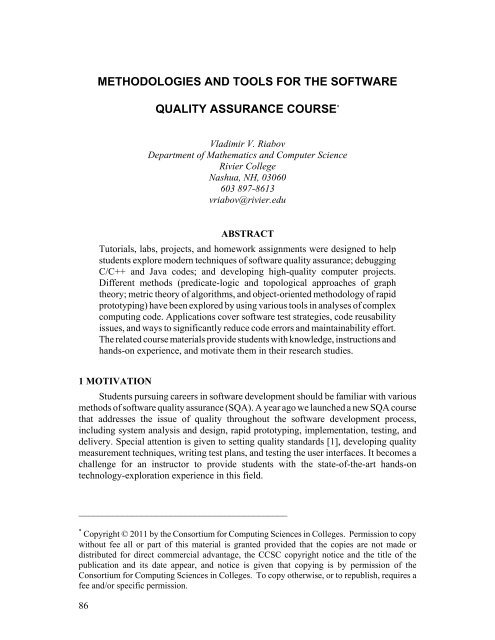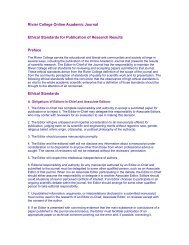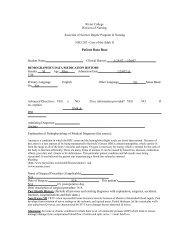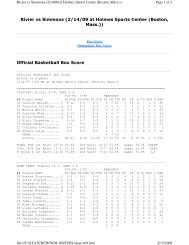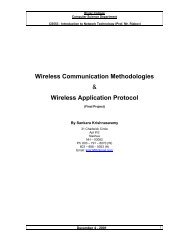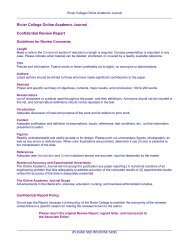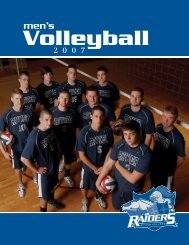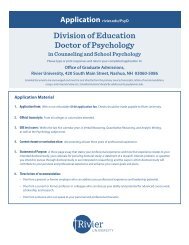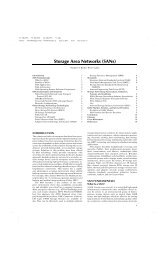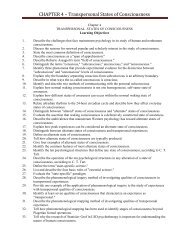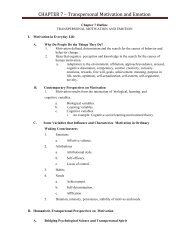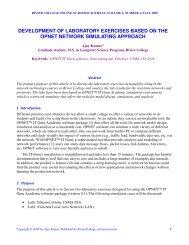methodologies and tools for the software quality ... - ResearchGate
methodologies and tools for the software quality ... - ResearchGate
methodologies and tools for the software quality ... - ResearchGate
Create successful ePaper yourself
Turn your PDF publications into a flip-book with our unique Google optimized e-Paper software.
METHODOLOGIES AND TOOLS FOR THE SOFTWARE<br />
QUALITY ASSURANCE COURSE *<br />
Vladimir V. Riabov<br />
Department of Ma<strong>the</strong>matics <strong>and</strong> Computer Science<br />
Rivier College<br />
Nashua, NH, 03060<br />
603 897-8613<br />
vriabov@rivier.edu<br />
ABSTRACT<br />
Tutorials, labs, projects, <strong>and</strong> homework assignments were designed to help<br />
students explore modern techniques of <strong>software</strong> <strong>quality</strong> assurance; debugging<br />
C/C++ <strong>and</strong> Java codes; <strong>and</strong> developing high-<strong>quality</strong> computer projects.<br />
Different methods (predicate-logic <strong>and</strong> topological approaches of graph<br />
<strong>the</strong>ory; metric <strong>the</strong>ory of algorithms, <strong>and</strong> object-oriented methodology of rapid<br />
prototyping) have been explored by using various <strong>tools</strong> in analyses of complex<br />
computing code. Applications cover <strong>software</strong> test strategies, code reusability<br />
issues, <strong>and</strong> ways to significantly reduce code errors <strong>and</strong> maintainability ef<strong>for</strong>t.<br />
The related course materials provide students with knowledge, instructions <strong>and</strong><br />
h<strong>and</strong>s-on experience, <strong>and</strong> motivate <strong>the</strong>m in <strong>the</strong>ir research studies.<br />
1 MOTIVATION<br />
Students pursuing careers in <strong>software</strong> development should be familiar with various<br />
methods of <strong>software</strong> <strong>quality</strong> assurance (SQA). A year ago we launched a new SQA course<br />
that addresses <strong>the</strong> issue of <strong>quality</strong> throughout <strong>the</strong> <strong>software</strong> development process,<br />
including system analysis <strong>and</strong> design, rapid prototyping, implementation, testing, <strong>and</strong><br />
delivery. Special attention is given to setting <strong>quality</strong> st<strong>and</strong>ards [1], developing <strong>quality</strong><br />
measurement techniques, writing test plans, <strong>and</strong> testing <strong>the</strong> user interfaces. It becomes a<br />
challenge <strong>for</strong> an instructor to provide students with <strong>the</strong> state-of-<strong>the</strong>-art h<strong>and</strong>s-on<br />
technology-exploration experience in this field.<br />
___________________________________________<br />
*<br />
Copyright © 2011 by <strong>the</strong> Consortium <strong>for</strong> Computing Sciences in Colleges. Permission to copy<br />
without fee all or part of this material is granted provided that <strong>the</strong> copies are not made or<br />
distributed <strong>for</strong> direct commercial advantage, <strong>the</strong> CCSC copyright notice <strong>and</strong> <strong>the</strong> title of <strong>the</strong><br />
publication <strong>and</strong> its date appear, <strong>and</strong> notice is given that copying is by permission of <strong>the</strong><br />
Consortium <strong>for</strong> Computing Sciences in Colleges. To copy o<strong>the</strong>rwise, or to republish, requires a<br />
fee <strong>and</strong>/or specific permission.<br />
86
CCSC: Nor<strong>the</strong>astern Conference<br />
Topics covered include <strong>the</strong> integration of <strong>quality</strong> activities into <strong>the</strong> <strong>software</strong> project<br />
life cycle, CASE <strong>tools</strong> overview, structured testing methodology, complexity <strong>and</strong><br />
object-oriented metrics, configuration management, capability maturity models, <strong>software</strong><br />
engineering practices <strong>and</strong> st<strong>and</strong>ards, code re-engineering strategies, <strong>and</strong> miscellaneous<br />
topics.<br />
Students were encouraged to examine various <strong>software</strong>-development projects.<br />
Exploring different testing strategies, <strong>the</strong>y analyzed computer code by using various<br />
<strong>software</strong>-organization metrics including cyclomatic complexity [2], Halstead's [3] <strong>and</strong><br />
object-oriented metrics [4], <strong>and</strong> re-designed <strong>the</strong> code with lower risk level <strong>and</strong> errors.<br />
This paper contains an overview of <strong>the</strong> SQA <strong>software</strong> <strong>tools</strong>, tutorials, lab manuals,<br />
homework assignments, project reports, <strong>and</strong> research papers of students who took <strong>the</strong><br />
Software Quality Assurance course. The advantages of using <strong>the</strong>se <strong>tools</strong> <strong>for</strong> instruction<br />
in online <strong>and</strong> hybrid courses are also discussed.<br />
2 TOOLS FOR SOFTWARE QUALITY ANALYSIS<br />
2.1 Industrial SQA Tool Used in Software Engineering<br />
One of <strong>the</strong> most popular SQA <strong>tools</strong>, <strong>the</strong> McCabe IQ <strong>software</strong> package, was<br />
selected <strong>for</strong> exploring various study cases <strong>and</strong> projects in <strong>the</strong> course on <strong>software</strong> <strong>quality</strong><br />
assurance. This industrial tool became available <strong>for</strong> students under <strong>the</strong> free-license<br />
agreement with <strong>the</strong> McCabe University Program. The tool allows <strong>the</strong>m to explore<br />
McCabe's structured testing methodology [2] that became a widely used method in code<br />
analyses, unit <strong>and</strong> integration test planning, <strong>and</strong> test-coverage estimations. Following<br />
specially designed computer-lab assignments <strong>and</strong> using <strong>the</strong> McCabe IQ tool, students<br />
study how to apply <strong>the</strong> <strong>the</strong>ory of graphs <strong>for</strong> <strong>the</strong> complexity code analysis, develop test<br />
strategies, <strong>and</strong> predict possible errors [3, 6] in <strong>the</strong> code developed by <strong>the</strong>mselves <strong>and</strong><br />
companies. Un<strong>for</strong>tunately, <strong>the</strong> McCabe IQ package could be used only on campus;<br />
<strong>the</strong>re<strong>for</strong>e, o<strong>the</strong>r Open Source free-license SQA packages were evaluated <strong>for</strong> use by<br />
students at home, specifically when taking courses online or in <strong>the</strong> hybrid <strong>for</strong>mat.<br />
2.2 Open Source Free-License SQA Tools<br />
There are several Open Source free-license SQA <strong>tools</strong> available <strong>for</strong> students. The<br />
Java Source Metric package [7] has been used to analyze Java source code with <strong>quality</strong><br />
metrics like <strong>the</strong> Inheritance Depth, Lines of Code, <strong>and</strong> McCabe Complexity Metric suite.<br />
The CCCC tool [8] generates a report on various metrics (including <strong>the</strong> Lines of Code<br />
<strong>and</strong> McCabe's complexity) of C/C++ code. The freeware program SourceMonitor [9]<br />
has been used <strong>for</strong> code analysis to identify <strong>the</strong> relative complexity of code modules.<br />
SourceMonitor measures metrics <strong>for</strong> source code written in C++, C, C#, VB.NET,<br />
Java, Delphi, Visual Basic (VB6), <strong>and</strong> HTML. It operates within a st<strong>and</strong>ard Windows<br />
GUI <strong>and</strong> exports metrics to XML or CSV (comma-separated-value) files <strong>for</strong> fur<strong>the</strong>r<br />
processing with o<strong>the</strong>r <strong>tools</strong>. The COCOMO-II tool [10] was used by students to<br />
estimate <strong>the</strong> cost, ef<strong>for</strong>t, <strong>and</strong> schedule associated with <strong>the</strong>ir <strong>software</strong> development<br />
projects.<br />
87
JCSC 26, 6 (June 2011)<br />
3 LAB AND HOMEWORK ASSIGNMENTS<br />
The main goal of labs <strong>and</strong> homework assignments is to introduce <strong>software</strong> <strong>quality</strong><br />
metrics <strong>and</strong> help students build <strong>the</strong>ir individual skills of code analysis, testing, <strong>and</strong><br />
redesign to improve code <strong>quality</strong> <strong>and</strong> enable possible reuse in o<strong>the</strong>r projects.<br />
3.1 Introducing <strong>the</strong> Structural Testing Methodology<br />
The first set of lab <strong>and</strong> homework assignments deals with implementation of <strong>the</strong><br />
structured testing methodology offered by McCabe [2]. The approach is based on<br />
graph-<strong>the</strong>oretical complexity-measuring techniques in code studies <strong>and</strong> control of<br />
program complexity. Using <strong>the</strong> experimental results of Miller [5], McCabe suggests that<br />
code modules approach zero defects when <strong>the</strong> module cyclomatic complexity is less than<br />
10. During lectures, <strong>the</strong> instructor provided an overview of <strong>the</strong> graph-based complexity<br />
metrics <strong>and</strong> <strong>the</strong> results of his systematic metric analyses of <strong>software</strong> <strong>for</strong> two industrial<br />
networking projects [6]. Following <strong>the</strong> lab assignments, students explored <strong>the</strong> McCabe<br />
IQ tool <strong>and</strong> used it to per<strong>for</strong>m metric analyses of several codes by applying cyclomatic<br />
complexity (v), essential complexity (ev), module design complexity, system design<br />
complexity, <strong>and</strong> system integration complexity metrics [2] in order to underst<strong>and</strong> <strong>the</strong><br />
level of complexity of a code module's decision logic, <strong>the</strong> code's unstructured constructs,<br />
a module's design structure, <strong>and</strong> <strong>the</strong> amount of interaction between modules in a program,<br />
as well as to estimate <strong>the</strong> number of unit <strong>and</strong> integration tests necessary to guard against<br />
errors.<br />
3.2 Estimating <strong>the</strong> Number of Code Errors <strong>and</strong> Ef<strong>for</strong>ts to Fix <strong>the</strong> Errors<br />
The second group of <strong>the</strong> lab <strong>and</strong> homework assignments was designed to introduce<br />
students to <strong>the</strong> comparative analyses of algorithm implementations in different languages<br />
(FORTRAN, C, C++, Java <strong>and</strong> some o<strong>the</strong>rs). Following Halstead's procedures [3],<br />
students identified all operators <strong>and</strong> oper<strong>and</strong>s, <strong>the</strong>ir frequencies, <strong>and</strong> estimated <strong>the</strong><br />
program length, vocabulary size, volume, difficulty <strong>and</strong> program levels, <strong>the</strong> ef<strong>for</strong>t <strong>and</strong><br />
time amounts to implement <strong>and</strong> underst<strong>and</strong> <strong>the</strong> program, <strong>and</strong> <strong>the</strong> number of delivered<br />
bugs (possible errors), B. They compared <strong>the</strong>ir findings with values calculated by using<br />
SQA <strong>tools</strong> (McCabe IQ, Java Source Metric, CCCC, SourceMonitor, <strong>and</strong><br />
COCOMO-II), <strong>and</strong> found that <strong>the</strong> results are sensitive to <strong>the</strong> programming language<br />
type (procedural or object-oriented).<br />
In particular, students found that ef<strong>for</strong>ts to implement <strong>and</strong> underst<strong>and</strong> <strong>the</strong> program<br />
were higher <strong>for</strong> procedural languages (FORTRAN <strong>and</strong> C) than <strong>for</strong> <strong>the</strong> object-oriented<br />
language (Java), even <strong>for</strong> simple algorithms, like Euclid's algorithm <strong>for</strong> calculating <strong>the</strong><br />
Greatest Common Divisor. They also found that large C/C++ source files [6] contain<br />
more actual errors than <strong>the</strong> number of delivered bugs (B) suggested [3].<br />
3.3 Interpreting Object-Oriented Metrics<br />
The third group of <strong>the</strong> lab <strong>and</strong> homework assignments was developed to help<br />
students identify clusters of object-oriented metrics that would better describe <strong>the</strong> major<br />
88
CCSC: Nor<strong>the</strong>astern Conference<br />
characteristics of object-oriented systems (properties of classes, polymorphism,<br />
encapsulation, inheritance, coupling, <strong>and</strong> cohesion) implemented in computer code<br />
written in C++ <strong>and</strong> Java. Their findings are summarized in Table 1 below.<br />
Metric<br />
Class Polymorphislatiotanclinsion<br />
Encapsu-<br />
Inheri-<br />
Coup-<br />
Cohe-<br />
Weighted Methods Per Class Yes Yes<br />
Response For Class Yes Yes<br />
Percentage of Public Data<br />
Yes<br />
Accesses to Public Data<br />
Yes<br />
Lack of Cohesion of Methods Yes Yes Yes<br />
Number of Children<br />
Yes<br />
Number of Parents<br />
Yes<br />
Depth in Inheritance Tree<br />
Yes<br />
Coupling Between Objects Yes Yes<br />
Attribute Hiding Factor Yes Yes<br />
Method Hiding Factor Yes Yes<br />
Polymorphism Factor Yes Yes<br />
Table 1. Clusters of Object-Oriented Metrics<br />
Students also identified some specific object-oriented metrics (Weighted Methods<br />
per Class, Response from a Class, Lack of Cohesion between Methods, <strong>and</strong> Coupling<br />
between Objects) that are <strong>the</strong> important factors <strong>for</strong> making a decision about <strong>the</strong> code<br />
module/class re-usability.<br />
3.4 Comparing Two Releases of <strong>the</strong> Code<br />
The last, fourth set of <strong>the</strong> lab <strong>and</strong> homework assignments was offered to students<br />
to identify major factors that <strong>for</strong>ced programmers to change <strong>the</strong> code [6] in <strong>the</strong> project<br />
redesign ef<strong>for</strong>ts. After analysis of <strong>the</strong> project <strong>software</strong> (about 300,000 lines of C-code)<br />
using <strong>the</strong> network-protocol approach 271 modules of <strong>the</strong> old Code Release 1.2 [6] were<br />
recommended <strong>for</strong> redesign. The re-engineering ef<strong>for</strong>ts resulted in <strong>the</strong> deletion of 16 old<br />
modules <strong>and</strong> in <strong>the</strong> addition of 7 new modules <strong>for</strong> <strong>the</strong> new Code Release 1.3. Analyzing<br />
<strong>the</strong> deleted modules, students found that 7 deleted modules were unreliable (v > 10) <strong>and</strong><br />
6 deleted modules were unmaintainable (ev > 4). Also, 19% of <strong>the</strong> deleted code was both<br />
unreliable <strong>and</strong> unmaintainable. Moreover, all seven new modules are reliable <strong>and</strong><br />
maintainable.<br />
After redesign, code changes resulted in <strong>the</strong> reduction of <strong>the</strong> code cyclomatic<br />
complexity by 115 units. 70 old modules (41% of <strong>the</strong> code) were improved, <strong>and</strong> only 12<br />
modules (about 7% of <strong>the</strong> code) deteriorated. This analysis demonstrates a robustness of<br />
<strong>the</strong> structured testing methodology <strong>and</strong> successful ef<strong>for</strong>ts in improving <strong>the</strong> <strong>quality</strong> of <strong>the</strong><br />
Code Releases. Studying <strong>the</strong> relationship between <strong>software</strong> defect corrections [6] <strong>and</strong><br />
cyclomatic complexity, students found a positive correlation between <strong>the</strong> numbers of<br />
possible errors, unreliable functions (with v > 10), <strong>and</strong> error submissions [6] from <strong>the</strong><br />
89
JCSC 26, 6 (June 2011)<br />
Code Releases (see Fig. 1) in <strong>the</strong> implementation ef<strong>for</strong>ts <strong>for</strong> six network protocols (BGP,<br />
FR, IP, ISIS, OSPF, <strong>and</strong> RIP).<br />
Figure 1: Correlation between <strong>the</strong> Number of Error Submits, Number of Unreliable<br />
Functions (v > 10), <strong>and</strong> <strong>the</strong> Number of Possible Errors <strong>for</strong> Six Network Protocols.<br />
4 STUDENTS' PROJECTS AND RESEARCH STUDIES ON SQA<br />
As <strong>the</strong> main assignment <strong>for</strong> <strong>the</strong> SQA course, students were asked to develop <strong>the</strong>ir<br />
individual or team projects on <strong>the</strong> <strong>quality</strong> analysis of moderate-size computer programs<br />
written in an object-oriented language (C++ or Java) <strong>and</strong> compare different releases of<br />
<strong>the</strong> code. The project assignment included <strong>the</strong> study of <strong>the</strong> code complexity <strong>and</strong> <strong>quality</strong><br />
based on <strong>the</strong> analysis of cyclomatic complexity metrics, Halstead's metrics, <strong>and</strong><br />
object-oriented design metrics by using available SQA <strong>tools</strong> (McCabe IQ, Java Source<br />
Metric, CCCC, SourceMonitor, <strong>and</strong> COCOMO-II). The project reports included<br />
<strong>the</strong> code structure chart, "Battlemap"; McCabe's Complexity Metrics summary; examples<br />
of flowgraphs with low, moderate, <strong>and</strong> high complexity; scatter diagrams with<br />
identification of unstructured-unreliable, reliable-structured, unreliable-structured, <strong>and</strong><br />
reliable-unstructured modules; examples of flowgraphs with <strong>the</strong> independent paths <strong>for</strong><br />
<strong>the</strong> unit tests; Halstead's Metrics report with estimation of <strong>the</strong> total number of <strong>the</strong><br />
delivered errors (B); Object-Oriented Metrics report with basic interpretation of <strong>the</strong><br />
metrics; <strong>and</strong> recommendations to improve <strong>the</strong> code.<br />
Michael Jef<strong>for</strong>ds in his project, "Using SQA Metrics to Guide Refactoring of<br />
Medium to Large Scale Projects", developed a plan to reduce <strong>the</strong> overall complexity of<br />
<strong>the</strong> code while adding important functionality to <strong>the</strong> system that provided visualization<br />
of geophysical data. His code refactoring ef<strong>for</strong>ts took approximately 20 hours, but have<br />
reduced <strong>the</strong> number of tests by about 200 unit tests. Summarizing <strong>the</strong>se ef<strong>for</strong>ts, he offered<br />
two effective methods of refactoring. In <strong>the</strong> first method, he used weighting factors to<br />
"boil" McCabe's <strong>and</strong> Halstead's metrics down using a <strong>for</strong>mula M = v/10 + ev/4 + V/3000.<br />
This approach gives equal weights to v-cyclomatic <strong>and</strong> ev-essential complexity metrics.<br />
Combined <strong>the</strong>y have double <strong>the</strong> weight of Halstead's V-metric of <strong>the</strong> program volume [3].<br />
In <strong>the</strong> second method, three thresholds <strong>for</strong> cyclomatic complexities were used to chart<br />
improvement over time. His goal was to achieve 100% of methods below <strong>the</strong> cyclomatic<br />
complexity of 20 <strong>and</strong> less than 97% of methods below <strong>the</strong> cyclomatic complexity of 10.<br />
He achieved 100% <strong>for</strong> v < 20; 99.67% <strong>for</strong> v < 15, <strong>and</strong> 98.01% <strong>for</strong> v < 10. Michael<br />
described three stages of refactoring: 1) He started by refactoring classes to remove<br />
90
CCSC: Nor<strong>the</strong>astern Conference<br />
public variables <strong>and</strong> adding accessors; 2) Next, he chose any of <strong>the</strong> methods that ended<br />
up on <strong>the</strong> "hot" list that he could underst<strong>and</strong> <strong>the</strong> basic methodology, <strong>and</strong> <strong>the</strong>n tried to<br />
tighten up <strong>the</strong> algorithms; 3) Finally, he worked on <strong>the</strong> hardest methods once he felt that<br />
his plan had taken shape <strong>and</strong> he could see a direction <strong>for</strong> fixing <strong>the</strong> architecture of <strong>the</strong><br />
worst classes.<br />
In <strong>the</strong> o<strong>the</strong>r project, Timothy Houle <strong>and</strong> Douglas Selent analyzed <strong>the</strong> complexity of<br />
<strong>the</strong> Light-Up Puzzle program [11], its maintainability, testability <strong>and</strong> metrics related to<br />
<strong>the</strong> <strong>quality</strong> of <strong>the</strong> <strong>software</strong> program's design. The application's vulnerabilities were<br />
identified by using <strong>the</strong> McCabe IQ tool. This approach helped <strong>the</strong>m to identify<br />
vulnerable code areas, reduce error rates, shorten testing cycles, improve maintainability,<br />
<strong>and</strong> maximize reusability. In order to verify <strong>the</strong> effectiveness of <strong>the</strong> McCabe IQ tool,<br />
<strong>the</strong>y re-factored <strong>the</strong> program in <strong>the</strong> areas reported to be highly complex <strong>and</strong> error-prone.<br />
After this, <strong>the</strong>y compared <strong>the</strong> McCabe's Metrics reports on <strong>the</strong> initial analysis to <strong>the</strong><br />
reports on <strong>the</strong> re-factored analysis <strong>and</strong> charted results to clearly indicate <strong>the</strong><br />
improvements made to decrease complexity. In addition to <strong>the</strong> McCabe metrics, <strong>the</strong><br />
students also added various UML diagrams [1], which helped <strong>the</strong>m underst<strong>and</strong> <strong>the</strong><br />
concept of <strong>the</strong> program structure <strong>and</strong> identify areas where object-oriented design<br />
principles could be applied to increase code reusability <strong>and</strong> maintainability.<br />
5 EFFECTIVENESS OF THE COURSE AND STUDENTS' RESPONSE<br />
All 16 computer-science graduate students that took <strong>the</strong> SQA course in <strong>the</strong> spring<br />
of 2010 expressed in <strong>the</strong>ir course evaluations full satisfaction with course organization,<br />
content, <strong>and</strong> material delivery. The overall course-evaluation score was high (4.71 out of<br />
maximum possible 5.0). In <strong>the</strong>ir anonymous comments, students shared mostly favorable<br />
observations, e.g., "This is a practically-oriented course <strong>and</strong> it has a lot of dem<strong>and</strong> in <strong>the</strong><br />
job market…"; "The instructor opened my eyes to <strong>the</strong> importance <strong>and</strong> usefulness of SQA<br />
metrics…"; "I learnt a lot of how <strong>the</strong> SQA is h<strong>and</strong>led in <strong>the</strong> <strong>software</strong> development<br />
process…"; "Great experience…", <strong>and</strong> "I met my expectations more than I thought."<br />
Later <strong>the</strong>se students effectively used <strong>the</strong> SQA techniques to improve <strong>the</strong>ir <strong>software</strong><br />
programs in o<strong>the</strong>r courses, including <strong>the</strong> final capstone projects. All <strong>the</strong> students are<br />
currently employed by local computer companies.<br />
6 CONCLUSIONS<br />
The author has described <strong>the</strong> challenges <strong>and</strong> experience of running <strong>software</strong> <strong>quality</strong><br />
assurance courses <strong>for</strong> undergraduate seniors <strong>and</strong> graduate students. The knowledge of<br />
graph <strong>the</strong>ory <strong>and</strong> its applications in <strong>software</strong> engineering is beneficial <strong>for</strong> students with<br />
Computer Science majors. Detailed analysis of code complexity reveals areas of code<br />
structures that should be revised. The code revision allows students to find those code<br />
areas with potential errors <strong>and</strong> to improve code design <strong>and</strong> testing practices. In particular,<br />
<strong>the</strong> resulting analysis can be used in identifying error-prone <strong>software</strong>, measuring optimum<br />
testing ef<strong>for</strong>ts, predicting <strong>the</strong> ef<strong>for</strong>t required to maintain <strong>the</strong> code <strong>and</strong> break it into<br />
separate modules, reallocating possibly redundant code, <strong>and</strong> providing a fundamental<br />
basis <strong>for</strong> unit <strong>and</strong> integration testing. The complexity code analysis <strong>and</strong> structured testing<br />
91
JCSC 26, 6 (June 2011)<br />
methodology should become a necessary attribute of <strong>software</strong> design, implementation,<br />
testing, sustaining, <strong>and</strong> re-engineering practice <strong>and</strong> training.<br />
REFERENCES<br />
[1] Galin, D., Software Quality Assurance: From Theory to Implementation, New<br />
York: Pearson Education, 2004.<br />
[2] Watson, A. H., McCabe, T. J., Structured Testing: A Testing Methodology Using<br />
<strong>the</strong> Cyclomatic Complexity Metric, NIST Special Publication, No. 500-235.<br />
Gai<strong>the</strong>rsburg, MD: National Institute of St<strong>and</strong>ards <strong>and</strong> Technology, 1996.<br />
[3] Halstead, M. H., Elements of Software Science. New York: North Holl<strong>and</strong>, 1977.<br />
[4] Rosenberg, L.H., Applying <strong>and</strong> Interpreting Object-Oriented Metrics. In<br />
Proceedings of <strong>the</strong> Tenth Annual Software Technology Conference, April 18-23,<br />
1998. Salt Lake City, UT, 1998.<br />
[5] Miller, G., The Magical Number of Seven, Plus or Minus Two: Some Limits on<br />
Our Capacity <strong>for</strong> Processing In<strong>for</strong>mation. In Psychological Review, 63 (2),<br />
81-97, 1956.<br />
[6] Riabov, V. V., Networking Software Studies with <strong>the</strong> Structured Testing<br />
Methodology. In Computer Science <strong>and</strong> In<strong>for</strong>mation Systems. A<strong>the</strong>ns, Greece:<br />
ATINER, 2005, pp. 261-276.<br />
[7] Java Source Metric, SourceForge.Net, 2009,<br />
http://jsourcemetric.source<strong>for</strong>ge.net/, retrieved January 25, 2011.<br />
[8] Littlefair, T., CCCC: C <strong>and</strong> C++ Code Counter, SourceForge.Net, 1998,<br />
http://cccc.source<strong>for</strong>ge.net/, retrieved January 25, 2011.<br />
[9] SourceMonitor Freeware Program, Campwood Software, Inc., 2010,<br />
http://www.campwoodsw.com/sourcemonitor.html, retrieved January 25, 2011.<br />
[10] COCOMO II, University of South Cali<strong>for</strong>nia, 2010,<br />
http://sunset.usc.edu/csse/research/COCOMOII/cocomo_main.html, retrieved<br />
January 25, 2011.<br />
[11] Light-Up Puzzle Program, Puzzle-Loop.Com, 2009,<br />
http://www.puzzle-light-up.com/, retrieved January 25, 2011.<br />
92
The Journal of Computing<br />
Sciences in Colleges<br />
Papers of <strong>the</strong> Sixteenth Annual CCSC<br />
Nor<strong>the</strong>astern Conference<br />
April 15-16, 2011<br />
Western New Engl<strong>and</strong> College<br />
Springfield, Massachusetts<br />
John Meinke, Editor<br />
UMUC — Europe<br />
George Benjamin, Associate Editor<br />
Muhlenberg College<br />
Susan T. Dean, Associate Editor<br />
UMUC — Europe<br />
Michael Gousie, Contributing Editor<br />
Wheaton College<br />
Volume 26, Number 6 June 2011


